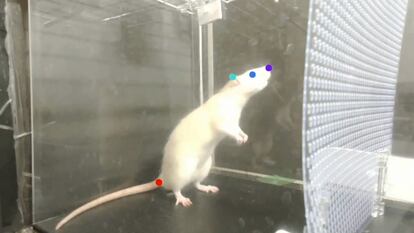Rats also ‘bop their heads’ when they listen to Queen
A group of researchers observed in a recent study that the rodents have an innate synchronization to musical beats
Music, it turns out, has a similar effect on the brain of rodents as it does on humans. A new study managed to record how rats synchronize their neurons at a rate of 120 to 140 beats per minute, something common in people when listening to songs. With this discovery the scientists conclude that the possibility of innately reacting to sound is present in the animal kingdom and it is not exclusive to humans. However, that inherent capacity to detect sound stimuli and synchronize to their rhythm does not entail the ability to create a melody.
Professor Hirokazu Takahashi’s goal was to find out if rodents feel music like humans do, a mystery for the rest of the animal world. With his team, the engineer from the University of Tokyo in Japan designed an experiment that was recently published in the scientific journal Science Advances, an investigation that shows that rats have an innate synchronization to beats without any previous exposure, a kind of short-term adaptation, according to Takahashi. “To the best of our knowledge, this is the first report on innate beat synchronization, except in humans.”
The researcher explains that he was very interested in the dynamics of the brain, especially the neuronal synchronization in response to acoustic stimuli. The first piece chosen to measure musical synchrony in animals was Mozart’s Sonata for Two Pianos in D Major, played at 4 different tempos.
To test this hypothesis about brain rhythm in rats, the scientists set up two parallel experiments. In one, they observed how sound transmission was captured through magnetic resonance imaging on sedated rats; in the other, they measured hundreds of neurons reacting simultaneously to sound stimuli thanks to an intracranial graft. They played 60-second intervals of the song at different speeds to see how they reacted. The same thing was observed in both experiments: the animals responded to the external stimulus of music automatically and a posteriori. Takahashi and his team concluded that rats have no ability to predict the song; they lack the sense of rhythm as we, as humans, understand it.
The rats, however, do react to bursts of sound with an instinctive – albeit not very obvious – head bopping. The researchers thought that their four-legged posture made synchronous movements difficult, so they decided to motivate the rodents to stand on two legs with a dropper on the roof of the cage to rule out whether this was actually rhythm or a simple spasm. In this way, they enhanced the reward mechanism associated with sound so that they moved their heads freely.

In addition to Mozart, Queen, Lady Gaga and Michael Jackson were also played, so the lab rats were able to capture the rhythm for any track, as long as it was within those 120 to 140 beats per minute, which is what they found most pleasurable.
Neural activity acts with rhythm. The brain generates it innately and it serves to synchronize its different areas. When an external sound enters the gray matter, the frequency is “reset,” and the neurons synchronize with that music. The rhythm of electrical discharges between neural connections is modulated by music.
Neuroscientist Robert J. Zatorre, co-director of the BRAMS Institute in Montreal, in Canada, explains that the human brain does not simply respond to the musical pulse, but it is actually capable of anticipating and predicting the next auditory stimulus by milliseconds. Thus, humans enjoy music because we are able to get ahead of the song we are listening to.
This is crucial for this expert in the study of music in the brain, because it is a sign of a more complex brain system. People build an internal model of the song, something like a psychological concept, he points out. Without this, we wouldn’t be able to dance or play instruments. Zatorre, who did not participate in the study, believes that it is important to analyze the evolutionary origin of musical enjoyment, because that can explain why we make music.

Dopamine, a neurotransmitter that encourages pleasurable actions, is at the base of what we learn. In the case of humans, music tends to be very present during adolescence because it is a very dopaminergic period in which the brain is still developing. Music at that age is pure dopamine: “It is an ancient evolutionary component that activates brain structures that are related with well-being; one that gained strength and remained there,” analyzes neuroscientist Juan Lerma, director of the Cajal International Neuroscience Center, in Spain.
For Lerma, the originality of the study lies in the fact that “it determines that the brain circuits in rats are very similar to those in humans.” He thinks music can affect the brain of all animals in general, although in a much simpler way, judging by the evidence gathered so far.
Takahashi admits that the study is not significant enough to make any statements regarding the “musical tastes” of other animals. His next goal is to find out if the rodents actually do enjoy the music thanks to an elaborate reward mechanism.
Tu suscripción se está usando en otro dispositivo
¿Quieres añadir otro usuario a tu suscripción?
Si continúas leyendo en este dispositivo, no se podrá leer en el otro.
FlechaTu suscripción se está usando en otro dispositivo y solo puedes acceder a EL PAÍS desde un dispositivo a la vez.
Si quieres compartir tu cuenta, cambia tu suscripción a la modalidad Premium, así podrás añadir otro usuario. Cada uno accederá con su propia cuenta de email, lo que os permitirá personalizar vuestra experiencia en EL PAÍS.
¿Tienes una suscripción de empresa? Accede aquí para contratar más cuentas.
En el caso de no saber quién está usando tu cuenta, te recomendamos cambiar tu contraseña aquí.
Si decides continuar compartiendo tu cuenta, este mensaje se mostrará en tu dispositivo y en el de la otra persona que está usando tu cuenta de forma indefinida, afectando a tu experiencia de lectura. Puedes consultar aquí los términos y condiciones de la suscripción digital.
More information
Últimas noticias
A floating school teaches children how to save Lake Atitlán
Pablo Escobar’s hippos: A serious environmental problem, 40 years on
The brief rise and retreat of Generation Z in Mexico
From Andorra to Gibraltar, a black market for Ozempic exploits its success: ‘They’re the most sought-after products in the world’
Most viewed
- Why we lost the habit of sleeping in two segments and how that changed our sense of time
- Charles Dubouloz, mountaineering star, retires at 36 with a farewell tour inspired by Walter Bonatti
- Venezuela faces its most tense Christmas yet
- CBS in crisis after pulling a report on Trump’s deportations to El Salvador (which later leaked online)
- Bukele clan fumes over investigation exposing their new wealth











































